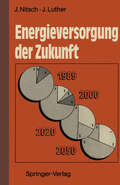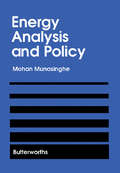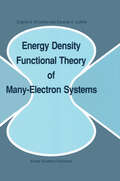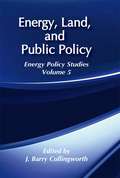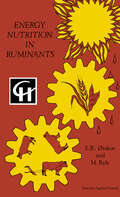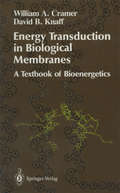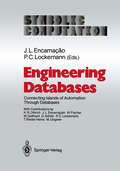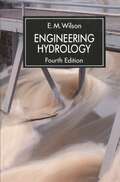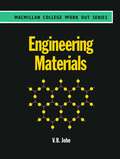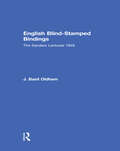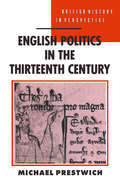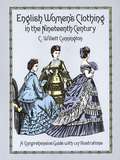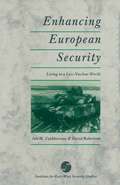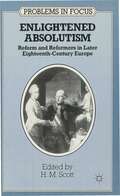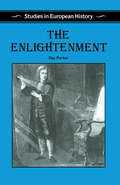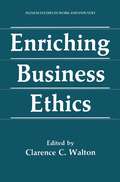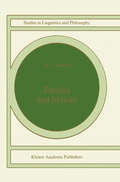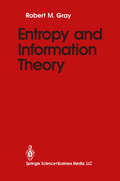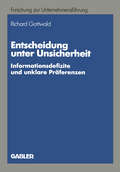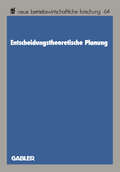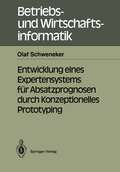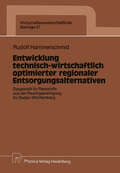- Table View
- List View
Energieversorgung der Zukunft: Rationelle Energienutzung und erneuerbare Quellen
by Joachim Nitsch Joachim LutherDas Buch behandelt Möglichkeiten einer zukünftigen Energieversorgung am Beispiel der Bundesrepublik Deutschland. Es werden Szenarien diskutiert, die auf effizientem Umgang mit Energie, intensiver Nutzung erneuerbarer Energiequellen und restriktivem Einsatz fossiler Energiequellen basieren. Insbesondere wird gezeigt, daß es konsistente Energieversorgungsstrukturen gibt, die bei weiter steigenden Energiedienstleistungen im Jahre 2050 nur noch ein Drittel bis ein Viertel des heutigen Verbrauchs an fossilen Energieträgern haben. Das Potential erneuerbarer Energiequellen (Sonne, Wind, Biomasse, Wasser) wird sowohl unter dem Gesichtspunkt der lokalen als auch der großflächigen Nutzung im Inland detailliert analysiert, ein möglicher Import von Solarstrom und Solarwasserstoff berücksichtigt. Im Zusammenhang mit der Einspeisung solarer Elektrizität in Verbundnetze gehen die Autoren auf die Fluktuationsproblematik und den damit verbundenen Speicherbedarf für hochwertige Energie ein. Sie runden den Themenkreis des Buches durch exemplarische Kostenanalysen solarer Einzeltechniken und insbesondere durch eine volkswirtschaftliche Bewertung der Sonnenenergienutzung ab. Neu an dem Buch ist der Versuch, systematisch rationelle Energienutzung und erneuerbare Energiequellen miteinander zu verknüpfen, um dem Leser einen technisch gangbaren Weg in eine solar-fossile Energiewirtschaft aufzuzeigen.
Energy Analysis and Policy: Selected Works
by Mohan MunasingheEnergy Analysis and Policy: Selected Works discusses the major aspect of electricity economics, including pricing, demand forecasting, investment analysis, and system reliability. This book provides a clear and comprehensive overview of the diversity of problems in analyzing energy markets and designing sound energy policies. Organized into 14 chapters, this book first discusses the energy economics in developing countries; integrated national energy planning (INEP) in developing countries; energy pricing; practical application of INEP using microcomputers; and energy strategies for oil-importing developing countries. Subsequent chapters describe the energy demand management and conservation; national energy policy implementation; energy demand analysis and forecasting; and energy project evaluation and planning. Other chapters explore non-conventional energy project analysis and national energy policy; rural energy issues and supply options; and bioenergy management policy. Rural-industrial energy and fossil fuel issues, as well as energy R&D decision-making in developing countries, are also presented. As the issues in this book are very important, this book will be helpful to a wide and appreciative audience.
Energy Density Functional Theory of Many-Electron Systems (Understanding Chemical Reactivity #4)
by Eugene S. Kryachko Eduardo V. LudeñaEnergy, Land and Public Policy (Energy and Environmental Policy Series #5)
by J. Barry CullingworthThe development of alternative forms of energy supply since the mid-1970s has brought with it a range of new issues and concerns, ranging from nuclear waste disposal to land use planning for energy efficiency. This latest volume in the acclaimed Energy Policy Studies series brings together an interdisciplinary group of researchers to examine the relationship between energy and planning policy, with emphasis on urban and regional impacts.Like other volumes in the series, the articles included focus on the social, political, and economic dimensions of energy technology, resources, and use. The emphasis on issues of technological scale, resource allocation, environmental impact and quality, and urban and regional studies makes this a unique contribution to the literature.Contents: "Creating Land-Energy Transitions," by Andrew F. Huston, U.S. Department of Housing and Urban Development; "Land Use Planning for Energy Efficiency," by Susan E. Owens, Cambridge University; "Nuclear Waste Landscapes," by Barry Solomon, U.S. Energy Information Administration; "Economic Development, Growth and Land Use Planning in Oil and Gas Producing Regions," by Robert L. Mansell, University of Calgary; "The Land Use Focus of Energy Impacts," by M. J. Pasqualetti, Arizona State University; "Energy Use and Land Use," by Stephen Lonergan, McMaster University; and a concluding essay by J. Barry Cullingworth, University of Delaware.
Energy, Land and Public Policy (Energy and Environmental Policy Series #5)
by J. Barry CullingworthThe development of alternative forms of energy supply since the mid-1970s has brought with it a range of new issues and concerns, ranging from nuclear waste disposal to land use planning for energy efficiency. This latest volume in the acclaimed Energy Policy Studies series brings together an interdisciplinary group of researchers to examine the relationship between energy and planning policy, with emphasis on urban and regional impacts.Like other volumes in the series, the articles included focus on the social, political, and economic dimensions of energy technology, resources, and use. The emphasis on issues of technological scale, resource allocation, environmental impact and quality, and urban and regional studies makes this a unique contribution to the literature.Contents: "Creating Land-Energy Transitions," by Andrew F. Huston, U.S. Department of Housing and Urban Development; "Land Use Planning for Energy Efficiency," by Susan E. Owens, Cambridge University; "Nuclear Waste Landscapes," by Barry Solomon, U.S. Energy Information Administration; "Economic Development, Growth and Land Use Planning in Oil and Gas Producing Regions," by Robert L. Mansell, University of Calgary; "The Land Use Focus of Energy Impacts," by M. J. Pasqualetti, Arizona State University; "Energy Use and Land Use," by Stephen Lonergan, McMaster University; and a concluding essay by J. Barry Cullingworth, University of Delaware.
Energy Nutrition in Ruminants
by M. Ryle and E. R. ØrskovThis book is intended to be a companion volume to 'Protein Nutrition in Ruminants' (1982, Academic Press), which emphasized both the role of proteins and new systems for their evaluation. Here the focus is on energy-yielding nutrients and problems involved in evaluating them. Nonetheless in both volumes there is explicit recognition of the interdependence of energy and protein nutrition. I have not attempted to review comprehensively all the literature relating to ruminant energy nutrition and must apologize to colleagues whose work is not fully reported. Where possible tables and figures are taken from the studies of our group at the Rowett Research Institute since, if for no other reason, I am most familiar with these data. I have first considered the nutrition of the newborn and have stressed the role of behaviour 'in determining whether nutrients enter or bypass the rumen. The development of the rumen, the of anaerobic fermentation and the roles of various principles . species of rumen bacteria, protozoa and fungi in relation to different substrates, are summarized. This is followed by accounts of the factors affecting the utilization of different substrates and the v vi Preface absorption and metabolism of the end-products of fermentation and digestion, together with estimates of digestive capacity in various segments of the gut. The ruminant's requirements for energy-yielding nutrients is considered in relation to the per formance of various activities and to environmental conditions, particular attention being paid to the requirement for glucose precursors.
Energy Transduction in Biological Membranes: A Textbook of Bioenergetics (Springer Advanced Texts in Chemistry)
by William A. Cramer David B. KnaffEnergy Transduction in Biological Membranes was primarily designed for graduate courses in bioenergetics. Not only does it discuss basic principles and concepts central to modern membrane biochemistry, biophysics and molecular biology, but also (1) the components and pathways for electron transport and hydrogen ion translocation, and (2) the utilization of electrochemical ion gradients. The book is unique in presenting a comparative treatment of respiratory and photosynthetic energy transduction, and in using protein sequence data coupled with physical concepts to discuss the mechanisms of energy transducing proteins.
Engineering Databases: Connecting Islands of Automation Through Databases (Symbolic Computation)
by K. R. Dittrich J. L. Encarnacao W. Fischer W. Gotthard D. Köhler P. C. Lockemann T. Riedel-Heine M. UngererAutomation is nothing new to industry. It has a long tradition on the factory floor, where its constant objective has been to increase the productivity of manufacturing processes. Only with the advent of computers could the focus of automation widen to include administrative and information-handling tasks. More recently, automation has been extended to the more intellectual tasks of production planning and control, material and resource planning, engineering design, and quality control. New challenges arise in the form of flexible manu facturing, assembly automation, and automated floor vehicles, to name just a few. The sheer complexity of the problems as well as the state of the art has led scientists and engineers to concentrate on issues that could easily be isolated. For example, it was much simpler to build CAD systems whose sole objective was to ease the task of drawing, rather than to worry at the same time about how the design results could be interfaced with the manufacturing or assembly processes. It was less problematic to gather statistics from quality control and to print reports than to react immediately to first hints of irregularities by inter facing with the designers or manufacturing control, or, even better, by auto matically diagnosing the causes from the design and planning data. A heav- though perhaps unavoidable - price must today be paid whenever one tries to assemble these isolated solutions into a larger, integrated system.
Engineering Hydrology: Solutions to Problems (pdf) (Macmillan Civil Engineering Hydraulics Ser.)
by E M WilsonEngineering Hydrology
by E.M. WilsonAn established and popular text written for students of civil engineering and practising engineers. Plenty of practical examples are provided, as well as problems for the reader to attempt.
Engineering Materials (Macmillan Work Out)
by V B JohnWork Out Engineering Materials has been written to cover all the essential information found in introductory materials courses in universities and polytechnics. The approach throughout is to develop topics through concise notes and fully worked examples with further self test questions for the reader to monitor progress. Work Out Engineering Materials is a thorough and rigorous supplementary reader developed to complement existing texts and lecture notes.
English Blind Stamped
by J. Basil OldhamThis book of the Sandar Lectures for 1949 confines itself to English blind-stamped bindings of the fifteenth, sixteenth and seventeenth centuries. Oldham, an authority on his subject, here describes his methods of study, and accounts for many groups of bindings that may be attributed to particular craftsmen or binderies. Oldham's experience includes all important English collections, His book devises a method of ornament-classification and description and is illustrated by 61 plates. A study of the tools used on blind-stamped bindings in England between the fifteenth and seventeenth centuries.
English Blind Stamped
by J. Basil OldhamThis book of the Sandar Lectures for 1949 confines itself to English blind-stamped bindings of the fifteenth, sixteenth and seventeenth centuries. Oldham, an authority on his subject, here describes his methods of study, and accounts for many groups of bindings that may be attributed to particular craftsmen or binderies. Oldham's experience includes all important English collections, His book devises a method of ornament-classification and description and is illustrated by 61 plates. A study of the tools used on blind-stamped bindings in England between the fifteenth and seventeenth centuries.
English Politics in the Thirteenth Century (British History in Perspective)
by Michael PrestwichThis book is an analytical study of English politics in the crucial period from John's reign to the Ordinance of 1311. It examines contemporary ideas about the nature of royal authority, and the attempts made to set limits on the crown. The nobility, is examined, as is the role of the church. The position of the gentry and the county community is assessed. Three specific issues are investigated, those of the position of foreigners at the court, military service, and taxation. The study concludes by examining of the concept of the community of the realm, and its relationship to parliament.
English Women's Clothing in the Nineteenth Century: A Comprehensive Guide with 1,117 Illustrations
by C. Willett CunningtonThe nineteenth century was a period of continuous change for women's clothing in England. The growing prosperity of the merchant class meant an ever-larger number of women for whom "dress" was a principal function in life, while the increasing availability of lower-priced ready-made garments enabled women of moderate means to purchase the fashions of the day. In addition, the development of the railways spurred the spread of new goods, while the removal of the tax on papers in 1854 produced an abundance of fashion magazines at cheap prices, bringing news of the latest styles to the multitudes.The magnificent array of ladies' fashions that characterized the century are on display in this remarkably complete decade-by-decade overview. Drawing almost exclusively on contemporary sources — fashion magazines, newspapers, rare period photographs, memoirs, Victorian novels, periodicals, and other publications, as well as firsthand observation of actual garments — the author describes and explains the couture that evolved in response to changing social conditions, technological innovations, and cultural developments.Over 1,100 line and tone drawings and photographs depict hundreds of outfits ranging from lovely morning dresses and starkly attractive riding outfits to elegant carriage costumes, opulent evening dresses, and exquisite bridal gowns. Full-page plates also depict period millinery, footwear, underclothing, and other apparel, while three useful glossaries provide descriptions of materials, definitions of technical terms, and more.Museum curators, vintage clothes collectors, and fashion historians will find this carefully researched and well-written book an indispensable tool for dating, identifying, and authenticating vintage clothing. Not only are styles described and illustrated in detail for each year; all the small details of construction by which specimens can be dated are given wherever possible. Moreover, designers, illustrators, and fashion enthusiasts will be delighted by the superbly detailed illustrations, which painstakingly document the fashionable finery of the Victorian era.
Enhancing European Security: Living in a Less Nuclear World
by Ian M. Cuthbertson David RobertsonAlthough the authors believe that the level of conventional and nuclear forces in Europe should and will be reduced, they do not consider that the military instrument will have lost all of its value in European political affairs. They still see a need to be prepared for tension and conflict.
Enlightened Absolutism: Reform and Reformers in Later Eighteenth-Century Europe (Problems in Focus)
Each book in this series is designed to make available to students important new work on key historical problems and periods that they encounter. Each volume, devoted to a central topic or theme, contains specially comisssioned essays from scholars in the relevant field. These provide an assessment of a particular aspect, pointing out areas of development and controversy and indicating where conclusions can be drawn or where further work is necessary, while an editorial introduction reviews the problem or period as a whole. In this text the contributors assess reform and reformers in late 18th century Europe, covering such topics as Catherine the Great, the Danish reformers, the Habsburg Monarchy and events in Spain and Italy.
The Enlightenment (Studies in European History)
by Roy PorterAfter having long been dismissed as a shallow irrelevance, the Enlightenment has now been rehabilitated as a major European movement in ideas and culture. Recent historical writing has shown how it was more than the airy philosophisings of a coterie of intellectuals - but rather a massive reorientation of thought, involving modernization, secularization and the application of science on a grand scale. These trends are surveyed and assessed in this book.
Enriching Business Ethics (Springer Studies in Work and Industry)
by Clarence C. WaltonOver thirty years ago, Alfred North Whitehead wrote: "If America is to be civilized, it has to be done (at least for the present) by the business class who are in possession of the power and the economic resources . . . . If the American universities were up to their job, they would be taking business in hand and teaching it ethics and professional standards. " * To the intellectual elites of his time, there was something of a minor in Whitehead's view. Few of them saw business as a civilizing force heresy and even fewer, feeling that business was not to be tamed, relished the role of the lion tamers. Not many today doubt Whitehead's wisdom. Organiza tions of wealth and power have accepted their corporate social responsibili ties, and universities have launched major efforts to provide ethical instruc tion for business personnel. So far as the scholars are concerned, they quickly came to realize the difficulty of an undertaking that seeks to redefine and apply moral criteria to a very complex corporate world. Philosophers, in particular, have learned (or perhaps have relearned) how their speculations on ethics must take into account the "living ethic" expressed in the American culture and here anthropologists, sociologists, and theologians were needed to provide an expertise that the moral manuals did not.
Entities and Indices (Studies in Linguistics and Philosophy #41)
by M.J. CresswellIn ordinary discourse we appear to ta1k about many things that have seemed mysterious to philosophers. We say that there has been a hitch in our arrangements or that the solution to the problem required us to examine all the probable outcomes of our action. So it would seem that we speak as if in addition to eloeks, mountains, queens and grains of sand there are hitches, arrangements, solutions, probiems, and probable outcomes. It is not immediately obvious when we must take such ta1k as really assuming that there are such to develop tests for things, and one of the tasks in this book is discerning what has eome to be called ontological commitment, in naturallanguage. Among the entities that natural language appears to make reference to are those connected with temporal and modal discourse, times, possibilities, and so on. Such entities play a crueial role in the kind of semantieal theories that I and others have defended over many years. These theories are based on the idea that an essential part of the meaning of a sentence is constituted by the conditions under whieh that sentenee is true. To know what a sentence says is to know what the world would have to be !ike for that sentence to be true.
Entscheidung unter Unsicherheit: Informationsdefizite und unklare Präferenzen (Betriebswirtschaftliche Forschung zur Unternehmensführung #23)
by Richard GottwaldEntscheidungstheoretische Planung (neue betriebswirtschaftliche forschung (nbf) #64)
by Edgar SaligerEntwicklung eines Expertensystems für Absatzprognosen durch Konzeptionelles Prototyping (Betriebs- und Wirtschaftsinformatik #44)
by Olaf SchwenekerIm Rahmen der vorliegenden Arbeit wird eine Methode zur Entwicklung von Expertensystemen vorgestellt, die die Vorteile des Prototyping mit denen einer modellbasierten Vorgehensweise verbindet und auf einem für das Projektmanagement in der Praxis unverzichtbaren Phasenschema basiert. Anhand dieser Methode wird die Realisierung des heute im Hause Bertelsmann eingesetzten Expertensystems für Lizenzeinkauf und Erstauflagendisposition (ELIED) beschrieben. ELIED prognostiziert Absatzverläufe von neuerscheinenden Büchern, ermöglicht die Anpassung an betriebswirtschaftliche Rahmenbedingungen und macht Vorschläge für Erst- und Nachauflagen. Ziel des Buches ist es, nach einer Diskussion grundsätzlich verschiedener Vorgehensweisen beim Knowledge-Engineering, den mit der Entwicklung von wissensbasierten Systemen beschäftigten Praktikern anhand eines vollständig beschriebenen Projektes ein geeignetes Vorgehensmodell für die eigene Entwicklungsarbeit vorzustellen. Die hier beschriebene Architektur eines Absatzprognosesystems kann auf zahlreiche andere Anwendungsgebiete projiziert werden.
